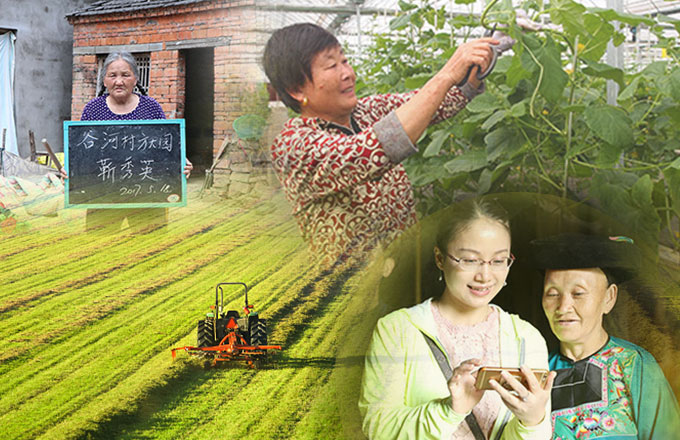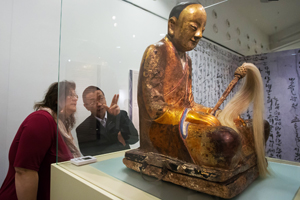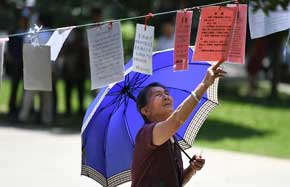Villagers demand name of disputed statue's new holder
 |
|
A senior tells tourists the story of the Pu Zhao Tang Temple in Yangchun.[Photo/China News Service] |
In court he read several reports and emails and produced a CT scan to show that two characteristics of the Zhang Gong statue-a hole in one of the hands and a wobbling head-were not present in the statue he bought.
When asked about the Chinese characters that read "Liu Quan"-Zhang Gong's given name-and "Pu Zhao Tang", the name of the village temple, written on a roll of linen found in the statue, he said: "The linen was added 200, 250 years later. It is not automatic proof that it belongs to the mummy."
When the judge inquired about the possibility of seeing the Buddha to check the evidence, Van Overeem said the new holder wishes to remain anonymous.
Holthuis showed the court numerous similarities between the statue and the Zhang Gong Patriach, arguing that the villagers are entitled to have their statue returned to its original place.
"There is objective evidence that Zhang Gong is Zhang Gong. Each time, Mr Van Overeem comes back to two arguments-no hole in one hand and no loose head. But we have no independent evidence, because he did the CT scan and now the Buddha is no longer in his possession," he said.
Lawyers representing the villagers also used the argument that Dutch law states "a person is not allowed to have the corpse of an identifiable person in their possession".
Van Overeem argued that what was discovered in the statue was not a "corpse" but "human remains", because "most of the organs are absent".
Burden of proof
Holthuis argued for a "reversal of the burden of proof".
"Mr Van Overeem does not have a purchase invoice or any document to show the origin of the Buddha," Holthuis told the court. "Chinese government records do not show any export permit for this Buddha. Besides, a permit to export the Zhang Gong Buddha would never have been granted," he said.
"A comparative study of the statue for proof or return is no longer possible because of his (Overeem's) actions."
Invoking recommendations adopted by the Ekkart Committee, a Dutch government body in charge of returning looted World War II artworks that remain in the hands of the Dutch state, Holthuis argued that it is up to Van Overeem to prove that the statue is not Zhang Gong.
The committee's recommendations are recognized by the Tweede Kamer, the lower house of the Dutch parliament.
Since the villagers' ownership of the Buddha statue has been proven to a high degree of probability and Van Overeem has not provided legally convincing indications to the contrary, "it is up to Mr Van Overeem to prove that the Buddha is not Zhang Gong", Holthuis told Xinhua.
- Villagers demand name of disputed statue's new holder
- Revised regulation on military document processing released
- Cirque du Soleil makes bold entry into China
- Six reporters, 30 days, one mission: Charting China's anti-poverty fight
- Suspect caught in connection to fatal Jiangsu house fire


























